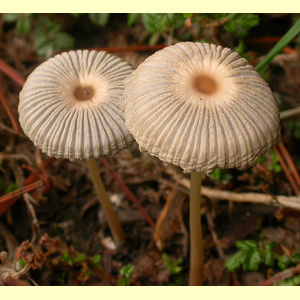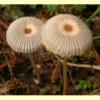
images/Parasola/Parasola_plicatilis_Gowrie_Park_Tas_05_syme.jpg
Small to medium agaric, growing on the ground or on litter or mulch, with a black spore print. Pileus brown or grey, plicate, not viscid. Lamellae remote, free or adnexed. Stipe central. Partial veil remnants absent. Fruit-body collapsing but not truly deliquescent. Spores reddish brown or brown, smooth; germ pore broad. Cheilocystidia present; pleurocystidia present. Lamellar trama regular or interwoven with age. Pileipellis a hymeniderm; lacking a universal veil; pileocystidia absent (present in some non Australian species). Clamp connections present, but can be difficult to locate.
Not truly deliquescent, as in other members of
Coprinus sens. lat., and also differing from
Coprinellus by the absence of a veil, and the constant presence of pleurocystidia, and from
Coprinopsis by the hymeniform pileipellis (rather than a cutis). Some species of
Psathyrella (which shares the black spore print) have a hymeniform pileipellis, but they are usually not as distinctly plicate as in
Parasola, nor do the lamellae become remote at maturity. Spores of
Parasola are often mitriform (shaped like a bishop's mitre), with one end broader than the other.
Parasola Redhead, Vilgalys & Hopple, Taxon 50: 235 (2001).
Two species: Australian material is mostly reported as
Parasola plicatilis. Other species probably occur in Australia given that several closely related species in the Northern Hemisphere appear to prefer particular substrates and habitats such as soil in lawns, bare soil, wood or dung (Breitenbach & Kranzlin 1995) and in Australia
P. plicatilis can be observed on a variety of substrates.
Grgurinovic (1997) included Coprinus virgulacolens in Parasola but Nagy et al. (2010a) consider that this species is more likely to belong in Coprinopsis.
W.A., S.A., N.S.W., Vic. and Tas. (and probably also N.T. and Qld).
In lawns and gardens, and possibly in native forest.
On ground or on twigs among mulch and litter.
Saprotrophic.
Bougher, N.L. (2009a),
Fungi of the Perth region and beyond: a self-managed field book, Western Australian Naturalists' Club (Inc.), Perth. [
Description and
Illustration of
P. plicatilis]
Breitenbach, J. & Kranzlin, F. (eds) (1995), Fungi of Swizerland. Volume 4. Agarics 2nd part. Edition Mykologia, Lucerne. [Description, Illustration and Microcharacters of P. plicatilis, and of several closely related species such as P. leiocephala, all under Coprinus]
Grgurinovic, C.A. (1997a), Larger Fungi of South Australia. The Botanic Gardens of Adelaide and State Herbarium and The Flora and Fauna of South Australia Handbooks Committee, Adelaide. [Description and Microcharacters of P. plicatilis and P. virgulacolens (both as Coprinus), and Key to South Australian species of Coprinus in a broad sense]
Nagy, L.G., Vágvölgyi, C. & Papp, T. (2010a), Type studies and nomenclatural revisions in Parasola (Psathyrellaceae) and related taxa, Mycotaxon 112: 103–141.
Orton, P.D. & Watling, R. (1979), British Fungus Flora. Agarics and Boleti. 2 / Coprinaceae Part 1: Coprinus. Royal Botanic Garden, Edinburgh. [Description, B&W Illustration and Microcharacters of P. plicatilis (as Coprinus)]


_AV49_sml.jpg)
